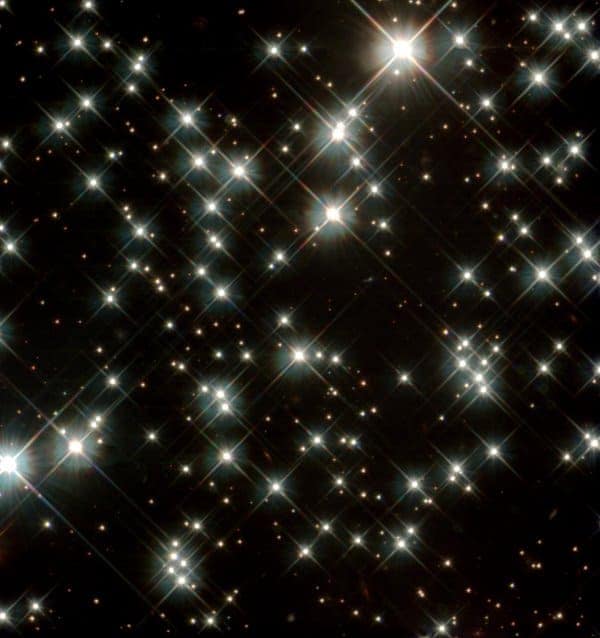
Physicists in the US claim that there may be “electroweak” stars lurking in the universe. Such stars are, the researchers say, what certain heavy stars could become once they have consumed their nuclear fuel supply and before they collapse into a black hole. This theoretical prediction suggests that our current understanding of stellar evolution may be incomplete.
Conventional stars exist as stable bodies because the outward radiation pressure of the energy released by their nuclear fusion reactions balances the inward gravitational force of the stellar matter. Once a star has burnt up all of its nuclear fuel it then implodes gravitationally. What happens next depends on how massive the star is. Stars below a certain mass collapse to form a neutron star, in which almost all protons are converted into neutrons. With electrostatic repulsion gone the star becomes incredibly dense. However, Pauli exclusion between neutrons prevents the ultimate collapse of lighter stars.
Relatively heavy neutron stars do eventually become black holes, but some scientists believe that on their way to infinite density these objects evolve into “quark stars”, in which neutrons break up into their constituent quarks. Glenn Starkman of Case Western Reserve University, together with De-Chang Dai and Dejan Stojkovic of the State University of New York in Buffalo and Arthur Lue of the Massachusetts Institute of Technology, have now studied what might happen to such stars as their quark matter is compressed to ever greater densities and pressures.
Conversion to leptons
The researchers say that the behaviour of the quarks should change fundamentally if the temperature of the star exceeds that at which the electromagnetic and weak forces effectively become one single force. Once above the electroweak temperature, quarks can convert into leptons, releasing huge amounts of energy in the process because the neutrinos emitted can drain away the energy from the core of a star. The ultimate collapse to a black hole would be stalled by this burning of quarks.
“This is a process predicted by the well tested Standard Model of particle physics,” says Starkman. “At ordinary temperatures it is so incredibly rare that it probably hasn’t happened within the visible universe anytime in the last 10 billion years, except perhaps in the core of these electroweak stars and in the laboratories of some advanced alien civilizations.”
If we believe in the Standard Model, we cannot escape this phase in stellar evolution of massive enough stars, Dejan Stojkovic, SUNY Buffalo
Stojkovic points out that stellar collapse can be viewed as the inverse of the expansion that took place after the Big Bang. He says that because massive quarks were created at electroweak temperatures as the universe expanded, so too must they be destroyed as stars reach these temperatures from the other direction. “If we believe in the Standard Model,” he adds, “we cannot escape this phase in stellar evolution of massive-enough stars.”
In their paper the researchers investigate how long a star can exist in such an “electroweak” state. Just as a star in its normal state avoids gravitational collapse by burning nuclear fuel, so in its electroweak state it would resist implosion by burning quarks. The team calculated the rate at which quark matter could pass from a star’s outer layers into its super-hot and dense core, and they found that the burning could last for up to 10 million years. This, they say, is long enough to consider such a star a distinct object in its own right – an electroweak star. In fact, says Starkman, if the burning process is efficient enough, such as star might consume sufficient mass that it never becomes a black hole at all.
Questions remain
Starkman admits that many questions remain. For example, he says, it is possible that a star’s electroweak phase may be highly unstable and might in fact last for no longer than a second. He also points out that observing such an object could be extremely tricky. Most of the energy emitted would be carried away by neutrinos, but given the inertness of neutrinos it is unlikely that any experiment could be made sensitive enough to detect them. Some energy is also likely to be removed by photons, but this fraction would be small. As a result, working out the likely electromagnetic signature of an electroweak star will require a detailed understanding of the outer layers of the star and how the photons pass through these layers, an understanding that the researchers do not yet have.
Pavel Kroupa of the University of Bonn in Germany says that this research “appears to be a beautiful application of standard physics” that “if true would mean the existence of an entirely new type of star”.
However, Paolo Gondolo of the University of Utah believes “it highly implausible that such an electroweak star would exist”. He maintains that the radiation pressure exerted by the burning quark fuel would be so strong that it would blow the outer layers of the star away.
The paper has been submitted to Physical Review Letters and has been posted on the arXiv server.



